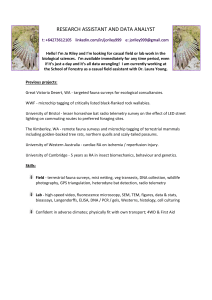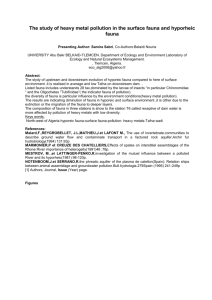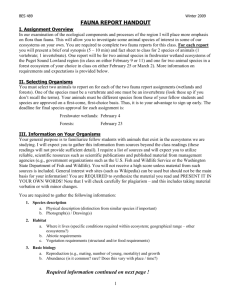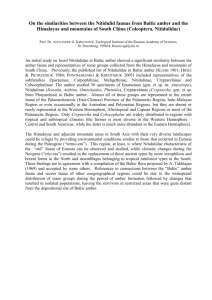paleo
advertisement
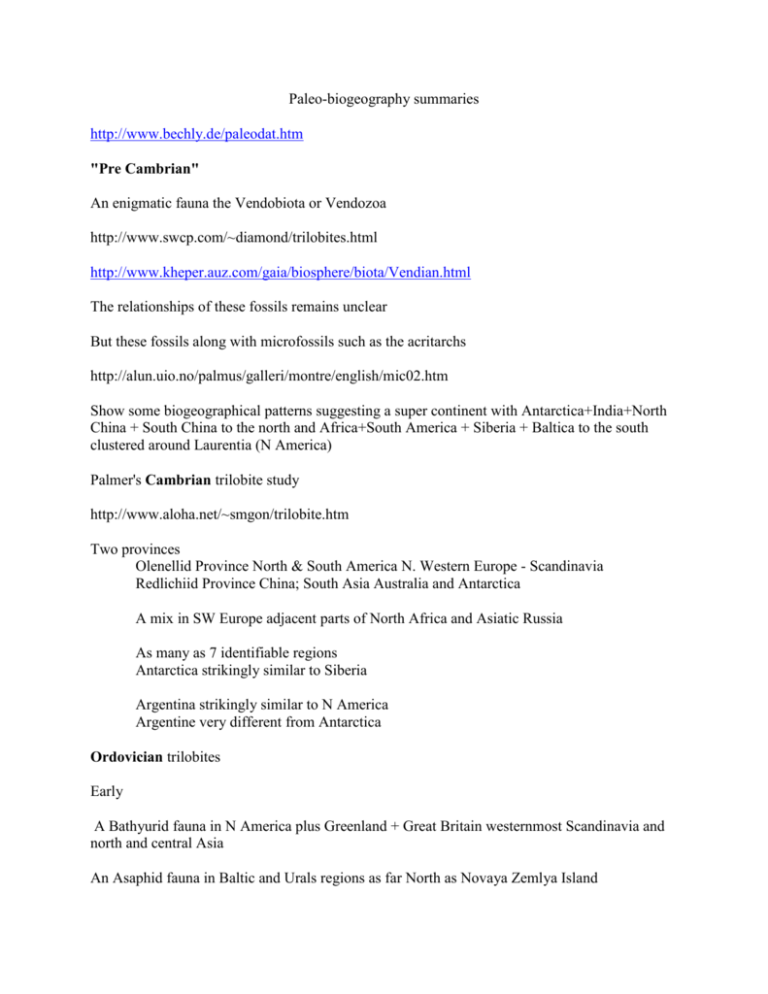
Paleo-biogeography summaries http://www.bechly.de/paleodat.htm "Pre Cambrian" An enigmatic fauna the Vendobiota or Vendozoa http://www.swcp.com/~diamond/trilobites.html http://www.kheper.auz.com/gaia/biosphere/biota/Vendian.html The relationships of these fossils remains unclear But these fossils along with microfossils such as the acritarchs http://alun.uio.no/palmus/galleri/montre/english/mic02.htm Show some biogeographical patterns suggesting a super continent with Antarctica+India+North China + South China to the north and Africa+South America + Siberia + Baltica to the south clustered around Laurentia (N America) Palmer's Cambrian trilobite study http://www.aloha.net/~smgon/trilobite.htm Two provinces Olenellid Province North & South America N. Western Europe - Scandinavia Redlichiid Province China; South Asia Australia and Antarctica A mix in SW Europe adjacent parts of North Africa and Asiatic Russia As many as 7 identifiable regions Antarctica strikingly similar to Siberia Argentina strikingly similar to N America Argentine very different from Antarctica Ordovician trilobites Early A Bathyurid fauna in N America plus Greenland + Great Britain westernmost Scandinavia and north and central Asia An Asaphid fauna in Baltic and Urals regions as far North as Novaya Zemlya Island A Selenopeltis fauna around the Mediterranean Sea A Hungaiid-calymenid fauna along the Andes NW India East China and Central Australia Late A Monorakid-remopleuridid fauna from N America+ Greenland through Great Britain the Baltic the Urals and N Central Asia A Trinucleid-Homalonotid fauna mostly circum Mediterranean but some representation in East Asia A Pliomerina-calymenid fauna in East Asia the Andes and perhaps the Cape plus Australia There was an Ordovician Gondwanan distribution represented by the Hungaiid-calymenid and later Pliomerina-calymenid fauna Bathyurid and later Monorakid-remopleuridid fauna was northern found widely from The Canadian shield; Scotland, Norway+ Spitsbergen to North Central Asia Ordovician conodonts http://www.science.uwaterloo.ca/earth/geoscience/conodont.html http://geology.csusb.edu/cdont_art.htm A North Atlantic (European) province extending from the rookies southward across southern US then up along the east coast and across to Great Britain and the Baltic A Mid-continent province centered in central N. America and extending toward the NE. Ordovician Brachiopods http://www.ucmp.berkeley.edu/brachiopoda/brachiopoda.html http://www.mpm.edu/reef/brachiopod.html A Gondwonan province throughout the Ordovician that included eastern South America. Southern and Eastern Africa Southern Arabian Peninsula South Asia south of the Himalayas. Characterized by the southern Hirnatia fauna The Northern regions were more complex. Early Ordovician An Orthidiella fauna from far Eastern Siberia to western North America An Orthidium fauna centered in NE North America A Baltic Gonoambonitid-Lycophoriid fauna And a central European Daimanillid fauna Later the Eastern N American seaboard was united with Great Britain/Baltic by the BimuriidChristianiid fauna. The former may have extended as far as central Asia A Gonambonitid fauna continued in western Asia The link between central and eastern N America with the British Isles and the Baltic continued through the Ordovician as did the far west N American-Siberian connection. Graptolites http://www.premdesign.com/grapto.html http://www.toyen.uio.no/palmus/galleri/montre/english/graptolites_liste_e.htm More mixing and more widely spread An Atlantic fauna found in British Isles, the Baltic the Mediterranean and N Africa and a Pacific fauna found in N America East China S E Australia and South Island New Zealand. The two were found together in the Andes and central and north Asia Corals showed a similar pattern with a generalized southern fauna and a complex set of northern faunas http://www.ucmp.berkeley.edu/cnidaria/rugosa.html http://www.ucmp.berkeley.edu/cnidaria/tabulata.html Fell attempted to rationalize these patterns1000 genera of sallow water invertebrates. He found two great faunal provinces I. Europe Africa S. America Africa shares 95% of its genera with Europe S America shares 44% of its genera with Europe S America shares 37% of its genera with N. America II N America Australia Greenland Central Asia Africa shares only 5% of its genera with S. America Australia shares 75% of its genera with N. America and Asia But only 9% with S. America and 2% with Africa Silurian Brachiopods I. A Malvino-kaffric province – eastern South America south of the Amazon; and the Cape plus parts of Antarctica II. A Northern province a) A wide spread North Atlantic sub-province stretching from N America East of the Rockies, South to the Amazon basin and east trough the Baltic, Scandinavia to the Urals b) a Ural-cordilleran sub-province that ranged through Asia east of the Urals to Northwestern-most N America and East Australia and New Zealand. There also existed a very localized Tuvaella brachiopod community in south central Asia. Devonian In the lower Devonian Malvinokaffaric brachiopods spread to Antarctica , western S America and the Gulf of Guinea This wide spread province diminished in range in the upper Devonian. The lower Devonian Appalachian province (Equivalent to the eastern part of the North Atlantic sub-province became restricted to eastern N America, but also spread to western S. America north of the Amazon. This continued through the upper Devonian. The lower Devonian Old world province (equivalent to the Ural-Cordilleran sub-province ranged across the far North from NW N America through the Mediterranean and much of Asia of eastern Australia. In the upper Devonian this province became even more widespread through Asia The Devonian saw the rise of fishes which contributed much to our knowledge of paleobiogeography. Heterostrachan fishes became common in the Silurian and Devonian. They were mostly centered in N. America west of the Rockies trough Great Britain, the Baltic Greenland Iceland and NE Asia. Much of this diversification was around the shores of a northern sea bounded by the Old Red Continent and an arctic N central Asian "Tungussian continent. Land plants also showed this pattern with a set of floras that ranged from N Africa through Great Britain, the Baltic and Scandinavia through Greenland and Western Canada. Carboniferous Corals showed some differentiation in their distribution I. A Cordilleran-North American region that spread from western North America across northernmost Asia. II A Eurasiatic region that was centered around the Mediterranean bud had a broad extension northward through the Urals and Eastward through Kazakhstan to SE Asia parts of China and N. E. Siberia to Novya Zemlya. This region also included the tip of Nova Scotia. III An East Australian region The Carboniferous also saw the development of amphibian fauns and the early rise of the reptiles. Some showed a N. American Great Britain central European distribution. Terrestrial floras during the Carboniferous showed an extremely widely distributed Lepidodendropsis flora http://www.ucmp.berkeley.edu/plants/lycophyta/protolepido.html http://ibs.uel.ac.uk/ibs/palaeo/pfr2/geosites.htm This world-wide flora was found in both N and S America, Greenland, N. Africa + the Cape; Great Britain, Iceland, central Europe all the way to eastern Asia and east Australia The second major flora of the Lower Carboniferous was the Angara flora that was restricted to NE Asia and Siberia. An identifiable sub province of the widespread Euramerican province was the Kazakhstan province running N-S thought Central Asia In the Upper Carboniferous the Euramerican Province became differentiated into a Cordilleran and a Cathasian sub-province along with the NE American and European core Euramerican subprovince. The Angaran province remained separate. Permian The differentiation of the Euramerian, Cathaysian and N. American provinces continued. The Angaran spread somewhat westward to include the Urals Fusulinids exhibited a Tethyan fauna extending E-W from Japan and S.E. Asia through Asia Europe to eastern N America. http://www.kgs.ukans.edu/Publications/ancient/f06_fusulin.html At the time of the late Paleozoic floral differentiation in the northern continents there was a great revolution n plant biology going on in the south http://www.paleoweb.org/smmWeb/smm/pages/plants1.htm#glo http://www.yale.edu/ynhti/curriculum/units/1991/6/91.06.05.x.html http://www.enchantedlearning.com/subjects/dinosaurs/glossary/indexg.shtml#Glossopteris A new kind of plant life appeared called Glossopteris http://www.biology.ualberta.ca/courses.hp/bot511/riasfl.htm http://www.paleoweb.org/smmWeb/smm/pages/plants1.htm http://www.yale.edu/ynhti/curriculum/units/1991/6/91.06.05.x.html This genus and related plants and associated flora was wide-spread throughout the 4 southern continents (Africa, Australia, Antarctica and S. America plus India It was this flora that was the main underpinning for the theory of a Gondwanan continent. http://www.enchantedlearning.com/subjects/astronomy/planets/earth/Continents.shtml
